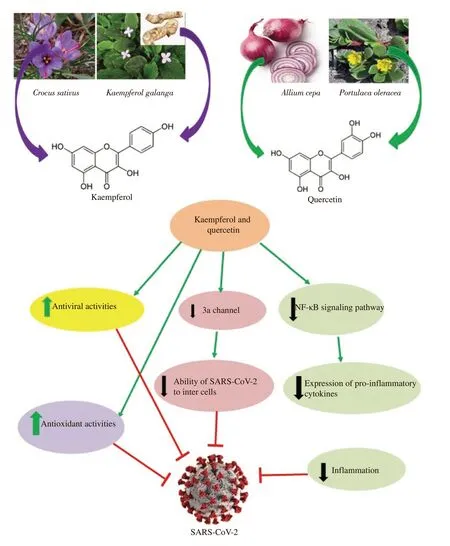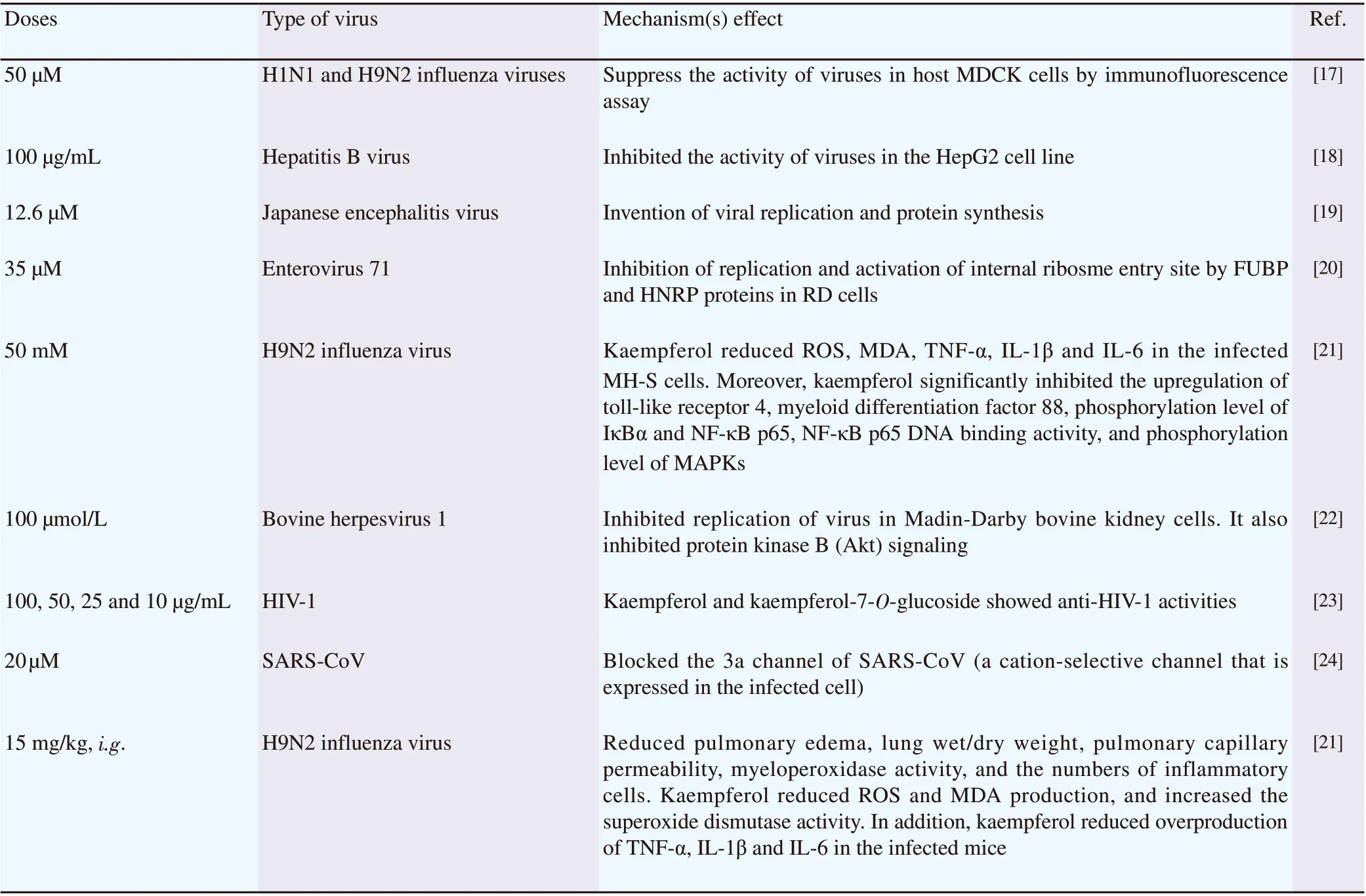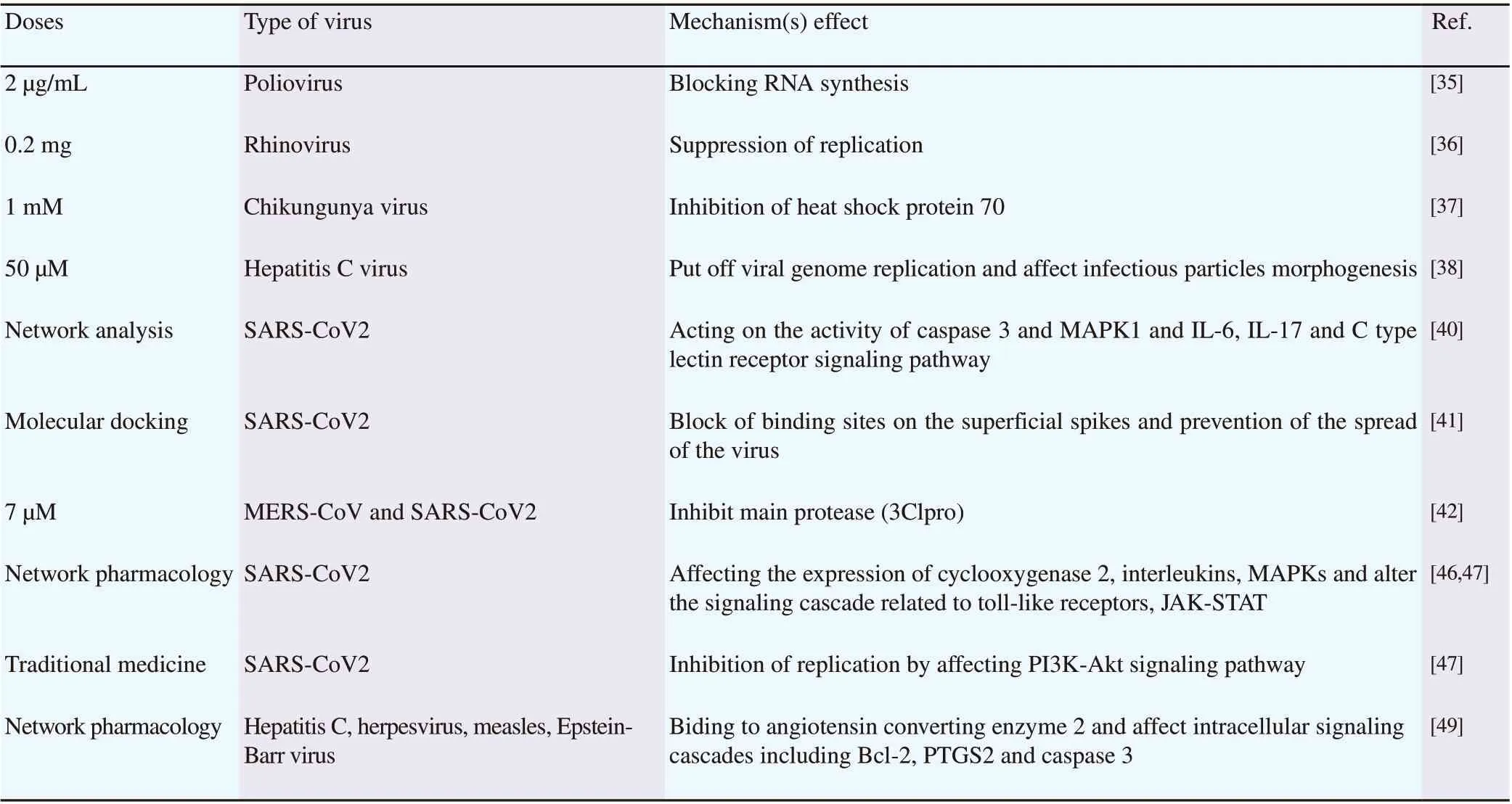Anti-viral and anti-inflammatory effects of kaempferol and quercetin and COVID-2019: A scoping review
2021-07-25MohammadRezaKhazdairAkbarAnaeigoudariGabrielAgbor
Mohammad Reza Khazdair, Akbar Anaeigoudari, Gabriel A. Agbor
1Cardiovascular Diseases Research Center, Birjand University of Medical Sciences, Birjand, Iran
2Department of Physiology, Jiroft University of Medical Sciences, Jirof, Iran
3Center for Research on Medicinal Plants and Traditional Medicine, Institute of Medical Research and Medicinal Plants Studies, Ministry of Scientific Research and Innovations, Yaounde, Cameroon
ABSTRACT Severe acute respiratory syndrome coronavirus type 2 (SARSCoV-2) is a novel coronavirus identified at the end of 2019. It is recognized as the causative agent of coronavirus disease 2019(COVID-19). Flavonoids have been shown to exhibit therapeutical effect on complications related to COVID-19. The present study reviews possible therapeutic benefits of flavonoids on SARSCoV-2. The Web of Science, PubMed, Scopus, and Google Scholar were searched using keywords: “COVID-19”, “SARS-CoV-2”,“Kaempferol” and “Quercetin” in the Title/Abstract. Relevant published articles in the English language until August 2020 were considered. Kaempferol and quercetin showed antiviral properties such as inhibition of protein kinase B and phosphorylation of protein kinase and blocking effects on a selective channel (3a channel) expressed in SARS-CoV infected cells. They also reduced the level of reactive oxygen species, expression of inducible nitric oxide synthase, pro-inflammatory mediators including TNF-α, IL-1α, IL-1β, IL-6, IL-10, and IL-12 p70, and chemokines. Kaempferol and quercetin might exert beneficial effects in the control or treatment of COVID-19 because of their antiviral, antioxidant, antiinflammatory, and immunomodulatory effects.
KEYWORDS: SARS-CoV-2; Flavonoids; Kaempferol; Quercetin;Immunomodulation; Anti-inflammatory; Antiviral effects✉To whom correspondence may be addressed. E-mail: khazdairMR@Bums.ac.ir,m.khazdair@yahoo.com
1. Introduction
The novel coronavirus (SARS-CoV-2) is an enveloped virus with a single-stranded RNA genome and the third known coronavirus after severe acute respiratory syndrome (SARS) and Middle East respiratory syndrome coronavirus (MERS-CoV)[1]. Infection with SARS-CoV-2 leads to severe respiratory disorders and pneumonia-like symptoms in humans[2]. SARS-CoV-2 has high transmissibility and infectivity compared with SARS and MERS[3].Acute respiratory distress syndrome (ARDS) is the most prevalent cause of death among patients infected with SARS-CoV-2[4].Cytokine storm is one of the main mechanisms for ARDS. Systemic inflammatory response resulted in release of a large amount of proinflammatory mediators and chemokines by immune system in SARS-CoV infection[5,6]. The number of CD4and CD8T cells as humoral responses was significantly reduced in the peripheral blood of patients infected with SARS-CoV-2[4]. Old people and patients with major chronic diseases including cancers, diabetes, and hypertension are at the highest risk of SARS-CoV-2[7]. The receptorbinding domain of SARS-CoV-2 has a great binding affinity to the human angiotensin-converting enzyme 2 (ACE2) receptors, which are widely expressed in various cells including lung, brain, kidney,and digestive tract[8]. Reduction of CD4and CD8T cells takes place in the acute phase of infection with SARS-CoV[9].
It has been suggested that the therapeutic options focused on the antiviral agents may alleviate SARS-CoV-2 symptoms as well as reduce the inflammatory responses[10]. Various biological compounds such as flavonoids have been reported to possess antiviral, antiinflammatory, antioxidant, and other therapeutic properties in nature[11,12]. Anti-SARS coronavirus 3C-like protease effects of plant-derived phenolic compounds have also been reported[13].
The present review article discussed the possible therapeutic action of flavonoids against SARS-CoV-2 in relation to their antiviral and anti-inflammatory activities. The possible therapeutic pathway of kaempferol and quercetin in affecting COVID-19 is shown in Figure 1.
2. Methods
In this narrative review, we used different databases such as PubMed,Web of Science, Scopus, and Google scholar to collect information by searching keywords “COVID-19”, “SARS-CoV-2”, “Kaempferol”,and “Quercetin”. In vivo and in vitro studies in the English language until August 2020 were considered. Non-English articles and letters to editor were omitted.
3. Kaempferol

Figure 1. Therapeutical pathway of kaempferol and quercetin in treating COVID-19.
Kaempferol is a flavonoid extracted from the medicinal herb Kaempferol galanga L, Crocus sativus, Portulaca oleracea, and some other plants. This compound was found in concentrations ranging from 0.625 to 5 μg/mL in the extract of plants. Antiinflammatory and immunomodulatory effects of kaempferol have been suggested[14]. Pharmacological effects of kaempferol including antioxidant, anti-inflammatory, anti-cancer, and anti-microbe properties were also reported[15,16].
3.1. Antiviral effects of kaempferol
Based on research results, kaempferol was shown to suppress the activity of influenza viruses such as H1N1 and H9N2[17] and hepatitis B virus in vitro studies[18]. Other results reported kaempferol at a very low concentration (12.6 μM) exhibited an anti-Japanese encephalitis virus effect. This effect was mediated through the inhibition of viral replication and protein synthesis[19]. Inhibition of enterovirus 71 replication and the activity of internal ribosome entry site by FUBP and HNRP have been documented by kaempferol[20].
In an in vitro study, H9N2 influenza virus-infected MH-S cells were treated with kaempferol (50 mM) and it significantly reduced ROS, malondialdehyde, TNF-α, IL-1β, and IL-6 accumulation.Moreover, kaempferol remarkably inhibited the upregulation of tolllike receptor 4, phosphorylation level of IκB-α and nuclear factorkB (NF-κB) p65, myeloid differentiation factor 88, NF-κB p65 DNA binding activity, and phosphorylation level of mitogen-actived protein kinases (MAPKs)[21].
Kaempferol at dose 100 μmol/L completely inhibited bovine herpesvirus 1 replication in Madin-Darby bovine kidney cells. It also affects the viral replication at the post-entry stages. Kaempferol showed potent antiviral properties due to inhibition of protein kinase B (Akt) signaling[22]. The anti-HIV-1 activities of flavonoids,kaempferol, and kaempferol-7-O-glucoside (10-100 μg/mL) have been reported[23].
The potency of kaempferol for blocking a cation-selective channel that is expressed in the infected cell (3a channel) of SARS-CoV has been shown. Kaempferol (20 μM) blocked more than 50 % of these channels[24]. In an in vivo study, kaempferol (15 mg/kg, i.g.)reduced pulmonary edema, lung wet/dry weight, myeloperoxidase activity, pulmonary capillary permeability, and the number of inflammatory cells in BALB/C mice intranasally infected with H9N2 influenza virus. Kaempferol also reduced production of TNF-α, IL-1β, and IL-6, and decreased ROS activity and production of malondialdehyde, while increasing the superoxide dismutase activity[21]. Antiviral effects of kaempferol are summarized in Table 1.
3.2. Anti-inflammatory effects of kaempferol
Kaempferol (25 and 50 μmol/L) significantly reduced the expression of TNF-α, IL-8, and macrophage inflammatory protein 1 alpha (MIP-1α) in human promonocytic U937 cells-derived macrophages (dU937)[22].
Treatment with kaempferol (100 μM) significantly increased forkhead box P3 (FOXP3), a protein-coding gene expressed in Treg cells. Furthermore, kaempferol amplified mRNA levels of FOXP3 and IL-10 in Treg cells. These results suggested that kaempferol may potentially be used for the treatment of autoimmune diseases[25]. The mRNA expression of matrix metalloproteinase-2 was suppressed by kaempferol (20, 40, 60, 80, and 100 μM). In addition, it inhibited the migration of cancer cells in a dose-dependent manner[26].
Kaempferol (20 μM) suppressed histamine and β-hexosaminidase secretion and reduced the expression of IL-4 and TNF-α at mRNA and protein levels in IgE-sensitized RBL-2H3 cells. It also inhibited P38 mitogen-activated protein kinases in the cells[27].
Adminstration of kaempferol (30 and 150 mg/kg, p.o.) reduced serum levels of TNF-α and IL-1β in rabbits fed with a highcholesterol diet. Furthermore, kaempferol down-regulated mRNA and protein expression of inflammatory mediators including E-selectin, intercellular adhesion molecule-1 (ICAM-1), and MCP-1 in the aorta of rabbits[28]. Therefore, kaempferol modulates the expression of inflammatory molecules at gene and protein levels and exerts anti-inflammatory activities.
Kaempferol administration was found to modulate allergic airway disease in ovalbumin-sensitized mice[29]. Subcutaneous administration of kaempferol (3, 30 and 100 mg/kg) decreased the levels of IL-5 and IL-13 (especially at 100 mg/kg) in the bronchoalveolar lavage fluid (BALF) and its effect was comparable to that of dexamethasone (1 mg/kg). Additionally, the expressions of cell markers (CD4, B220, MHC class Ⅱ, and CD40 molecule)in BALF cells were decreased by kaempferol[29]. Treatment with kaempferol before or after the establishment of allergic disease down-regulated Th2 cytokines.
Oral administration of kaempferol (50 mg/kg) significantly inhibited the antigen-induced passive cutaneous anaphylaxis response in IgE-sensitized mice[27]. Treatment of aged rats with kaempferol (2 or 4 mg/kg/day) inhibited NF-κB function by inhibiting the activation of nuclear factor-inducing kinase/IκB kinase and MAPKs signal pathways in rat kidney[30]. The anti-inflammatory properties of kaempferol are shown in Table 2.
4. Quercetin
Quercetin is a natural polyphenolic flavonoid with antioxidant,anticancer, and antiviral properties found in many plants such as Portulaca oleracea and Allium cepa[31]. Anti-inflammatory and anti-asthmatic effects of this agent were also reported[32].Pharmacological effects of quercetin including vasodilation and anti-microbe effects have been reported[33]. The immunoregulatory function of quercetin on dendritic cells (DCs) through suppressing the expression of CD40, CD80, and CD86 in lipopolysaccharide(LPS)-stimulated DCs has been shown[34].

Table 1. Antiviral effects of kaempferol.
4.1. Antiviral effects of quercetin
3-Methyquercetin could inhibit poliovirus by blocking RNA synthesis[35]. Quercetin also inhibits rhinovirus infection via suppression of replication[36]. This plant flavonoid has also been demonstrated to stop the chikungunya virus infection via inhibition of heat shock protein 70 serving as a receptor for this virus[37]. Quercetin along with apigenin and isorhamnetin inhibited the hepatitis C virus’s life cycle[38]. This effect is attributed to put off viral genome replication and affect infectious particles’morphogenesis. Quercetin has been suggested to inhibit murine coronavirus and dengue virus in vitro[39]. Quercetin administration has been shown to be effective in the treatment of SARS-CoV2 via acting on caspase 3, MAPK1 and NF-κB signaling pathways to suppress the elevated cytokine levels[40]. Quercetin has been reported to block the binding sites on the superficial spikes of the SARS-CoV2 and to prevent the spread of the virus[41]. The ability of quercetin to inhibit the main protease (3Clpro) from MERS-CoV and SARS-CoV2 has been also documented[42]. Alteration of human genes encoding proteins targeted by SARS-CoV2 is also attributed to quercetin[43].
In silico modeling showed that quercetin as potential highly effective disruptors of the initial infection process attaches to the interface between the SARS-CoV-2 viral spike protein and the epithelial cell ACE2 protein[44].
The results of a study showed that quercetin and kaempferol presented in Ficus benjamina leaves inhibited herpes simplex virus 1[45]. Quercetin along with kaempferol has been proposed to bind the proteins of SARS-CoV2 which is involved in inflammatory responses and modulation of immune system. They could affect the expression of cyclooxygenase 2, interleukins, MAPKs and alter the signaling cascade related to toll-like receptors and JAKSTAT pathway[46,47]. According to scientific evidence, quercetin and kaempferol derived from Huoxiang zhengqi could inactive SARS-CoV2. This antiviral effect is associated with the inhibition of the replication of SARS-CoV2 by affecting PI3K-Akt signaling pathway[48]. It is also predicted that quercetin and kaempferol have a high affinity for SARS-CoV2 3CL hydrolase[49]. These two flavonoids can join to ACE2 and affect intracellular signaling cascades including Bcl-2, PTGS2, and caspase 3 for inhibiting viral infection resulting from hepatitis C, herpesvirus, measles,and Epstein-Barr virus[49]. The antiviral effects of quercetin are summarized in Table 3.
4.2. Anti-inflammatory effects of quercetin
Pharmacological properties of quercetin such as antioxidant,anticancer, and antiviral effects have been reported[31]. Quercetin(0.5-50 μM) increased gene expression and production of IFN-γ,but down-regulated the production of IL-4 in normal peripheral blood mononuclear cells (1×10cells/mL). The beneficial effects of quercetin on immune system may be attributed to the induction of Th1-derived cytokines secretion and inhibition of Th2 derived cytokines secretion[50].

Table 2. Anti-inflammatory and immunomodulatory effects of kaempferol.

Table 3. Antiviral effects of quercetin.
Treatment of LPS-stimulated DCs with quercetin (6.25, 12.5,50, and 100 μg/mL) inhibited production of TNF-α and impaired production of cytokines and chemokines in a dose-dependent manner. Quercetin also remarkably reduced generation of cytokines(IL-1α, IL-1β, IL-6, IL-10, and IL-12 p70) and chemokines (MCP-1,MIP-1α, and MIP-1β) in stimulated DCs. Furthermore, quercetin significantly suppressed the enhanced expression of CD40, CD80,and CD86 in LPS-stimulated DCs[34].
Treatment of bone marrow-derived macrophages with quercetin (1,10, 50 μM) inhibited expression of inducible nitric oxide synthase(iNOS), TNF-α, IL-1β, and IκB-α phosphorylation induced by LPS.Furthermore, administration of quercetin (1 mg/kg/day, p.o.) in rats inhibited production of TNF-α and IL-1β and expression of iNOS induced by dextran sulfate sodium[51].
Quercetin (8 mg/kg/day, i.p) remarkably reduced the level of eosinophils (68.79%) in BALF of mice challenged with ovalbumin.Quercetin also reduced secretion of IL-4 and IL-5 as well as mRNA expression of MMP-9 and EPO but increased the level of IFN-γ in the BALF of treated mice compared to non-treated mice[52].
Topical administration of quercetin (0.01%), resveratrol (0.01%),and their combination (0.01%) in desiccating stress mice model of dry eye disease (DED) reduced corneal staining in mice. Quercetin,resveratrol, and combined therapy decreased concentration of IL-1α in tear compared to vehicle treatment. Furthermore, quercetin decremented CD4T cells desiccating stress-exposed mice[53].
The effect of quercetin in rheumatoid arthritis patients was studied.Treatment patients with quercetin (1 500 mg/day, p.o.) plus 100 mg azathioprine for 8 weeks, remarkably decreased the levels of IL-6, C3, and C4, but increased the level of IL-10 compared to the azathioprine plus placebo-treated group. Treatment with azathioprine alone did not significantly affect the level of intercellular adhesion molecule (ICAM-1) while treatment with quercetin significantlyreduced ICAM-1 compared to the azathioprine alone-treated group.Oral administration of quercetin in combination with azathioprine produced an immunomodulatory action by reducing the level of IL-6, ICAM-1, and complement proteins while it elevated the serum level of IL-10[54]. The anti-inflammatory effects of carvacrol, another flavonoid on chemical gas exposed patients were also reported[54].

Table 4. Anti-inflammatory and immunomodulatory effects of quercetin.
Kaempferol and quercetin showed antiviral properties via the inhibition of protein kinase B and phosphorylation of protein kinase and blockage of effects on a selective channel that is expressed in the infected cell by SARS-CoV (3a channel). They also reduced the level of ROS, expression of iNOS, pro-inflammatory cytokines including TNF-α, IL-1α, IL-1β, IL-6, IL-10, and IL-12 p70, and chemokines. The anti-inflammatory properties of quercetin are shown in Table 4.
5. Conclusion
This review descriptively highlights the possible effects of kaempferol and quercetin with their underlying mechanism(s) of action on COVID-19. According to the literature survey, anti-viral properties of these flavonoids are mediated through the inhibition of protein kinase B and phosphorylation of protein kinase and blocking effects on 3a channel. They also reduced the level of ROS, expression of iNOS, and pro-inflammatory mediators such as TNF-α, IL-1α, IL-1β, IL-6, IL-10, and chemokines.
Kaempferol and quercetin modulated immune responses by reduction of pro-inflammatory mediators such as IL-4, IL-1β, IL-6,transforming growth factor-β, and IL-17, and enhancement of antiinflammatory mediators such as IFN-γ and FOXP3. ARDS with cytokine storm of pro-inflammatory cytokines is the main death cause of COVID-19. Therefore, kaempferol and quercetin with antiinflammatory and immunomodulatory effects may be useful for the treatment of COVID-19. Although, more clinical studies are required to support drug effectiveness.
Conflict of interest statement
We declare that there is no conflict of interest.
Authors’ contributions
MRK was responsible for study design, literature search, prepared and revised the manuscript. AA helped in study design, literature search, and preparation of the manuscript. GAA was responsible for critical review and editing of the manuscript. All the authors approved the final version of the manuscript.
杂志排行
Asian Pacific Journal of Tropical Biomedicine的其它文章
- Valencene-rich fraction from Vetiveria zizanioides exerts immunostimulatory effects in vitro and in mice
- Bitter gourd extract improves glucose homeostasis and lipid profile via enhancing insulin signaling in the liver and skeletal muscles of diabetic rats
- Cytotoxic effects of Thai noni juice product ethanolic extracts against cholangiocarcinoma cell lines
- Antioxidant and antigenotoxic properties of Alpinia galanga, Curcuma amada, and Curcuma caesia
